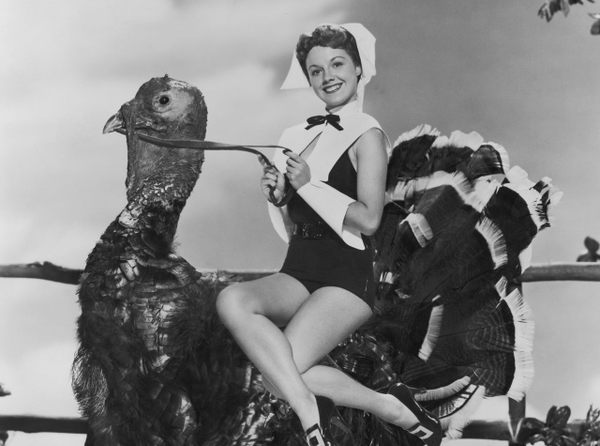Thanksgiving is just around the corner, and we’ve got seven little-known stories to tell at the dinner table this year. Learn why dry turkey is on the menu instead of cow tongue or raccoon, and meet the woman who spent 15 years trying to make Thanksgiving an official holiday. Consider adding banana to your seasonal spread, and read about the return of a lost Native language. Gather around the table to share these surprising tales of Thanksgiving history, food, and tradition.
by Luke Fater
In November of 1926, President Calvin Coolidge received a unique Thanksgiving gift: A woman from Mississippi sent him a raccoon, noting that it had a “toothsome flavor.” She suggested it would make for a satisfying Thanksgiving dinner. Eating raccoon wasn’t all that uncommon at the time. It’s believed that the practice started with Native Americans, and then passed to enslaved African people across the American South. The trend eventually spread north, first in low-income communities and then becoming integrated into middle- and upper-class diets. By 1926, raccoon was considered a food fit for the president, but Coolidge didn’t eat his new furry friend. Instead, he gave her a collar and a name: Rebecca. The lucky raccoon stayed with the Coolidges for the rest of the president’s term, before being given to the Rock Creek Park Zoo.
by Ariel Knoebel
While Thanksgiving is now celebrated as a time to come together, a 19th-century campaign to establish it as a permanent holiday was interpreted as a culture war against the American South. They considered it a Northern holiday intended to force New England values on the rest of the country. To them, pumpkin pie, a Yankee food, was a deviously sweet symbol of anti-slavery sentiment, writes Ariel Knoebel.

by Leigh Chavez-Bush
Pumpkin, apple, and sweet potato pie are all common at today’s classic American Thanksgiving, but in the 18th century, mincemeat pies took the center stage. These sweet and meaty pastries had one central ingredient that could be found among the most prestigious Thanksgiving spreads: cow tongue. Highly sought after, the rich, fatty meat was enjoyed by the upper class on special occasions and holidays. It’s uncertain why the food faded in popularity, but it probably had something to do with the rise of “muscle meats” replacing mincemeat.
by Natasha Frost
Until the mid-19th century, American farmers gave little thought to how they bred their turkeys, writes Natasha Frost. You simply bred your birds with whatever suitable mates you could get your hands on. That was until the 1850s, when “hen fever” hit America. People began to realize selectively breeding birds could yield a more delicious product for your plate. While most of this hen craze focused on chicken, people soon took an interest in turkeys, too. Despite the many delicious and carefully bred birds that would come to be in the following years, one turkey breed—the Broad White Breasted—has taken center stage for the past 60 years, and it’s not even very good.

by Natasha Frost
In 1993, 20-something Jessie Little Doe Baird awoke from a dream. This was just one of several she had where her ancestors came to her, speaking Wampanoag, the native tongue of the Cape Cod–based Mashpee Wampanoag tribe. Baird couldn’t understand them. At the time, there were no living speakers of Wampanoag.
To Baird, the dreams were a sign. She believed they were part of aWampanoag prophecy where their lost language would come back when they were ready for it. After years of struggling to piece together a language with no living speakers, in 2000, she published her thesis, An Introduction to Wampanoag Grammar. Since, she’s established a 10,000 word dictionary and helped found an immersion school for Wampanoag children, bringing the language back to life.
by Sarah Laskow
The first account of an American Thanksgiving tradition is from a letter written about a special pilgrim meal in 1621. The holiday quickly grew from a harvest supper to a Christian holiday, but by the 19th century, the feasting part became more important than the prayer. Governors in New England recognized state-wide thanksgiving days in late November or early December, but it wasn’t yet an official holiday. Northern writer Sarah Josepha Hale was one of the main advocates for making Thanksgiving a widespread and official tradition. In 1847, Hale released her first official pitch for the holiday, casting it as not only a Christian day of rest and prayer, but an effort to unite a growing nation.

by Anne Ewbank
On the tiny island of Norfolk, hundreds of miles from Australia’s mainland, a small community celebrates their own spin on an American-inspired Thanksgiving. Even stranger than the celebration is the backstory to the island’s population. The descendants of mutineers from the British ship HMS Bounty, as well as several captive Tahitians, founded a small community on the island in 1856. Today, many people on the island speak Norfuk, a combination of Tahitian and 18th-century English.
Visits from 19th-century American whalers spread the idea of Thanksgiving, which Norfolk Island resident Isaac Robinson took a liking to. One year, he decorated the pews of the All Saints Church with palm leaves and lemons. After Robinson died at sea, the islanders carried on the tradition. Just like at an American Thanksgivings, food is central to the holiday on Norfolk. A fusion of traditional Thanksgiving foods and local cuisine include banana pilaf, (green bananas cooked in cream, with dried bananas), roast meats, traditional Tahitian fish salad, and coconut bread.

